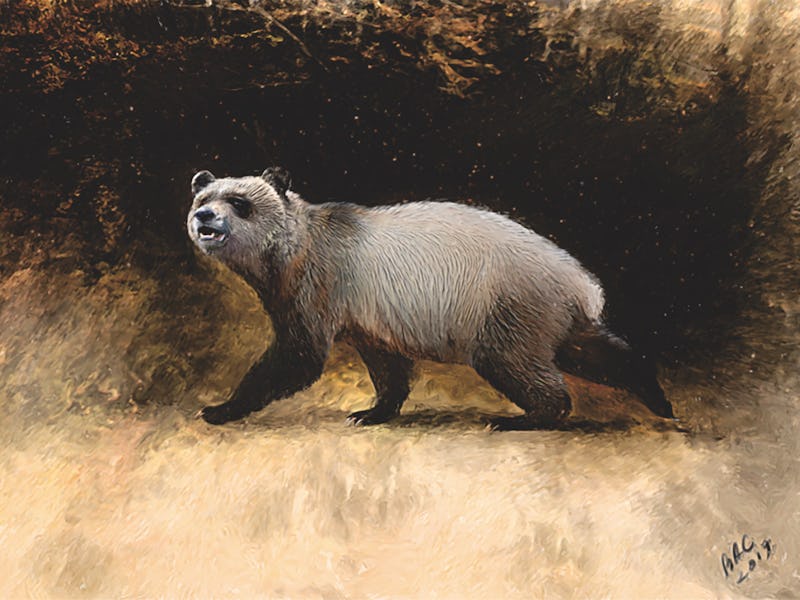These 6-million-year-old teeth may be from Europe’s last panda species
European pandas aren’t new, but this species makes our understanding of panda phylogeny more complex.

In the late 1970s in northwestern Bulgaria, paleontologists found two obsidian-black teeth, one curved upper canine, and one upper pre-molar.
Throughout the 1980s, paleontologist Ivan Nikolov preserved and studied these small but weighty specimens, housed in Bulgaria’s National Museum of Natural History. Then, paleontologist Nikolai Spassov took up his mantle.
“This is really my longest paleontological research, practically throughout my scientific career,” the paleontologist from the National Museum of Natural History at Bulgaria’s Academy of Sciences writes to Inverse.
Sparse clues guided him. He knew upon seeing the teeth that they had belonged to a fossil carnivore and that their black color likely came from fossilization in a coal deposit. However, he couldn’t say more than that. Then came several discoveries that would elucidate this puzzle, clarifying the carnivore as a member of the subfamily Ailuropodinae. This Ursinae subfamily’s members are entirely extinct save for one — the giant panda (Ailuropoda melanoleuca). “Gradually it became clear to me that the Bulgarian fossils represent a new species of giant panda,” he tells Inverse.
One fossil found in China called Ailurarctos became the oldest known panda fossil estimated at 7 or 8 million years old. Then, a discovery found in Spain now known as Kretzoiarctos supplanted it, dating back 10 to 12 million years. A third find in Hungary called Miomaci dated 7 or 8 million years old added further nuance to panda evolution. Spassov observed that his specimens “were much more evolved than [that of] the more ancient genera.”
Spassov reached out to his colleague Qigao Jiangzuo in Bejing who had suggested they join forces to investigate these teeth. Today, they publish their findings in The Journal of Vertebrate Paleontology, suggesting these two fossilized teeth came from a distinct giant panda species that lived about six million years ago.
The fossilized teeth of Ag. nikolovi don’t appear to be strong enough to crush bamboo, suggesting the bears fed on other plants.
What’s new — In describing these specimens, Spassov and Jiangzuo detail a new panda species dubbed Agriarctos nikolovi after Ivan Nikolov.
“People quite naturally associate this bear with a small area of China, and that’s why they are especially surprised when you tell them that a few million years ago, ancient pandas also inhabited Europe,” Spassov writes to Inverse.
European pandas aren’t new, but this species is, which makes our understanding of panda phylogeny a little more complex. What’s more, some of its habits may not seem panda-like. For one, it didn’t feast on bamboo because the plant wasn’t available to it, and, thus, its teeth weren’t equipped to chew the fibrous shoots.
After analysis, the team found that the teeth resembled those of the Chinese genus Ailurarctos, but also possessed features of the European Agriarctos. “There were no teeth from Europe so complex in morphology and so late in geological terms as the two teeth from Bulgaria,” Spassov writes.
Ag. nikolovi teeth compared with those from other specimens of Ailuropodini.
Why it matters — This discovery augments our understanding of pre-Asia pandas, informing paleontologists of more nuances of their evolution.
“These fossils are gap fillers, meaning that until now we did not know what happened to the bears that are closer to the extant panda, therefore improving the knowledge of the evolution of the Ailuropodinae outside Asia,” Juan Abella, a postdoctoral paleontology investigator at the Institut Català de Paleontologia Miquel Crusefont, writes to Inverse. Abella was the lead author on the paper describing the genus Kretzoiarctos found in Spain.
Furthermore, Spassov says this fossil is the most evolved known fossil genus ancestor of today’s giant panda. While Ag. nikolovi didn’t evolve into the giant panda, it is a relative. This may be an instance of parallel evolution, Spassov says, as the Bulgarian fossils are geologically the same age as the Chinese ones. “Jiangzuo and I make the assumption that the species from Bulgaria is probably still a product of parallel evolution and not a direct ancestor, not so much because of geographical distance, but mainly on the basis of some delicate relationships in the proportions of the cusps of the upper premolar,” he writes.
“The new fossil species from Bulgaria undoubtedly provides new data about this topic and new ideas about the possible paths of evolution of these strange animals as well as about the routes of the ancient dispersal of the panda ancestors and relatives,” Spassov adds.
Digging into the details — These teeth tell quite a story, Spassov notes. In fact, they show a surprisingly evolved bear.
“What was surprising to me was the complex morphology of the upper fourth premolar, perhaps the most important tooth for species identification in the panda group,” he writes.
He continues that his newfound species lacked the massive teeth and thick enamel the modern panda has for chomping on bamboo. Bamboo was also rare in Bulgaria at the time, so he hypothesizes the ancient bear fed on softer plant food. The fact that its teeth were found in coal deposits intimates the species had been living in wet forests.
What’s next — Spassov’s request to further panda research is both simple and difficult: more fossils. He wants to “reveal the essence of the Bulgarian fossil panda and the evolution of this strange animal, the giant panda.”
While Spassov wants novel evidence, Abella in turn wants novel, authoritative analysis that establishes panda phylogeny. “We will then be able to visualize the taxa that are closer to the extant giant panda in better perspective,” he writes. It will also quell arguments within this particular community of vertebrate paleontologists. “There are still several disagreements, but nothing that can't be solved without a couple more published papers.”
Spassov believes this is a worthwhile pursuit, all to “reveal the essence of the Bulgarian fossil panda and the evolution of this strange animal, the giant panda.”
This article was originally published on